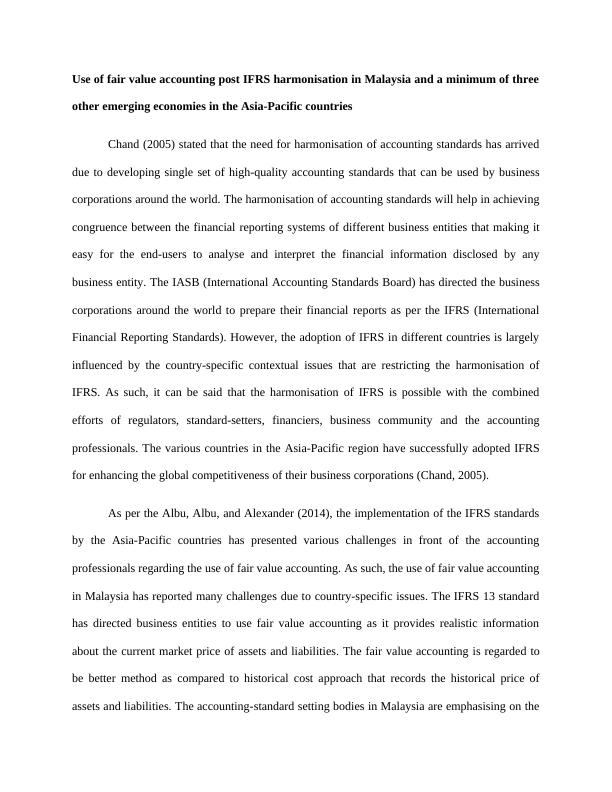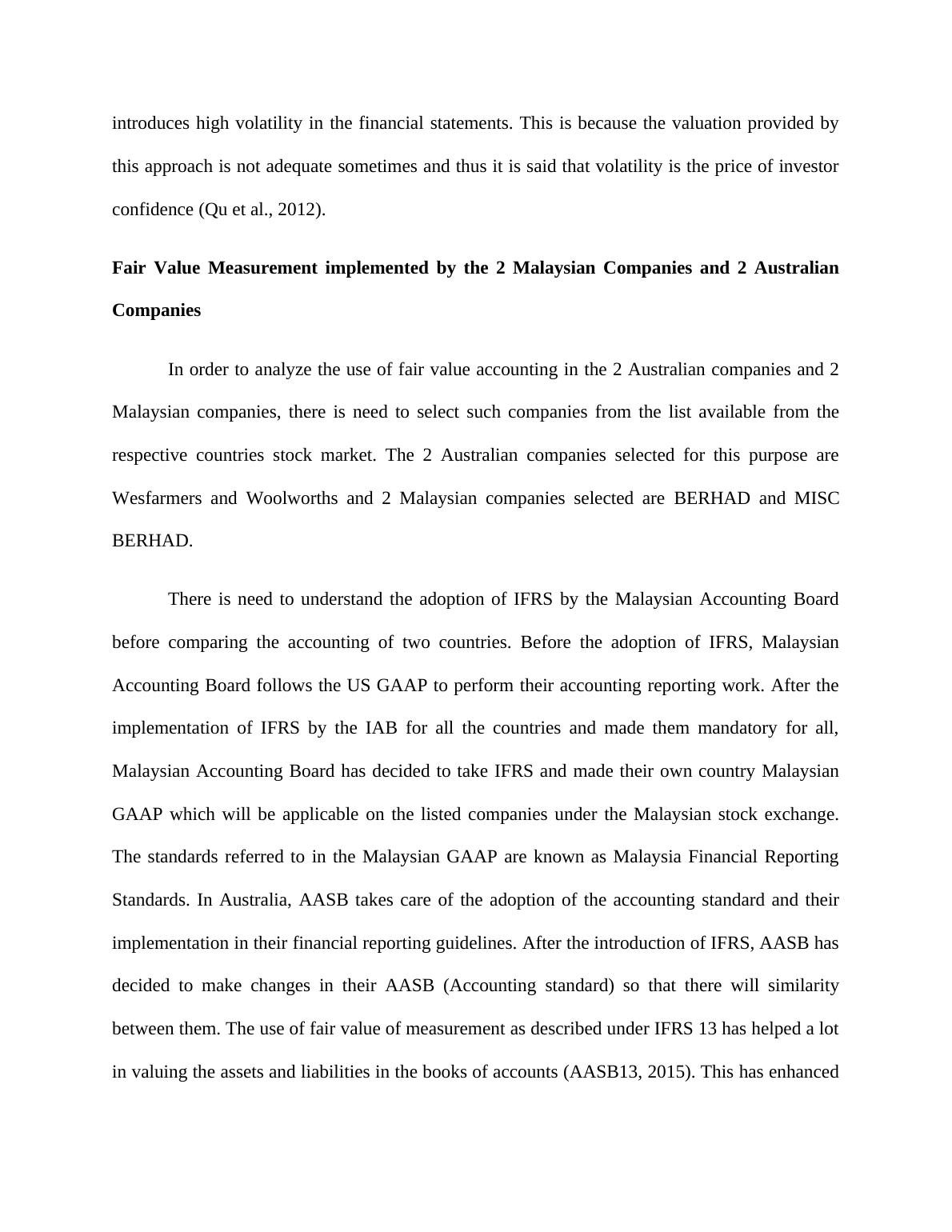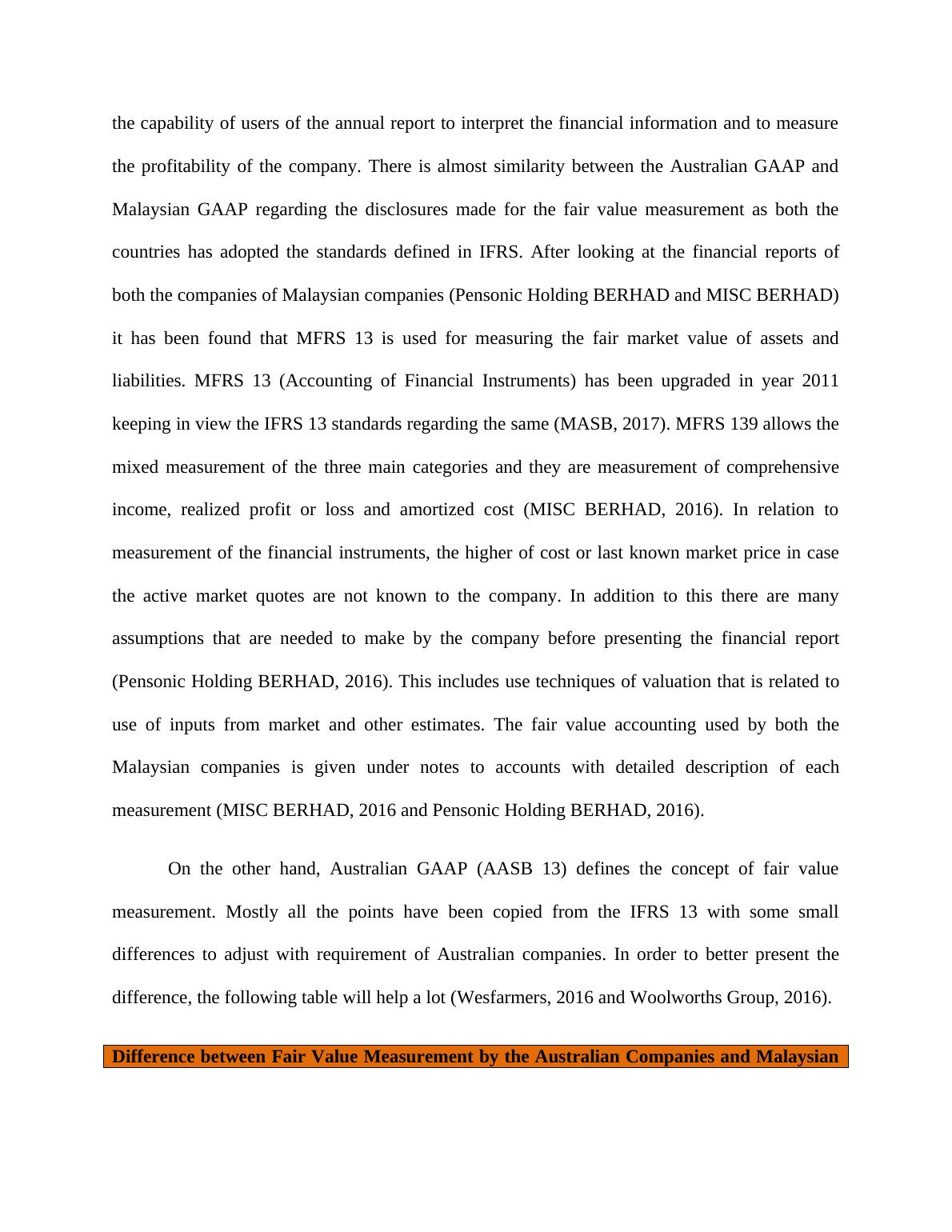The Harmonisation of Accounting Standards
Added on 2020-04-01
16 Pages3014 Words72 Views
Use of fair value accounting post IFRS harmonisation in Malaysia and a minimum of threeother emerging economies in the Asia-Pacific countriesChand (2005) stated that the need for harmonisation of accounting standards has arriveddue to developing single set of high-quality accounting standards that can be used by businesscorporations around the world. The harmonisation of accounting standards will help in achievingcongruence between the financial reporting systems of different business entities that making iteasy for the end-users to analyse and interpret the financial information disclosed by anybusiness entity. The IASB (International Accounting Standards Board) has directed the businesscorporations around the world to prepare their financial reports as per the IFRS (InternationalFinancial Reporting Standards). However, the adoption of IFRS in different countries is largelyinfluenced by the country-specific contextual issues that are restricting the harmonisation ofIFRS. As such, it can be said that the harmonisation of IFRS is possible with the combinedefforts of regulators, standard-setters, financiers, business community and the accountingprofessionals. The various countries in the Asia-Pacific region have successfully adopted IFRSfor enhancing the global competitiveness of their business corporations (Chand, 2005). As per the Albu, Albu, and Alexander (2014), the implementation of the IFRS standardsby the Asia-Pacific countries has presented various challenges in front of the accountingprofessionals regarding the use of fair value accounting. As such, the use of fair value accountingin Malaysia has reported many challenges due to country-specific issues. The IFRS 13 standardhas directed business entities to use fair value accounting as it provides realistic informationabout the current market price of assets and liabilities. The fair value accounting is regarded tobe better method as compared to historical cost approach that records the historical price ofassets and liabilities. The accounting-standard setting bodies in Malaysia are emphasising on the

use of fair value accounting with the increasing need for protecting the interests of the end-users.There are various other emerging Asia-Pacific economies that are adopting the use of fair valueaccounting approach besides Malaysia such as Australia, New Zealand and Singapore with theonly exception of Bangladesh (Albu, Albu, and Alexander, 2014). According to He, Wong and Young (2012), the historical cost accounting method reflectsthe initial price of assets and liabilities at the time of their purchase and does not provide anyinformation relation to the current market valuation. As such, it lacks reliability and therefore fairvalue accounting method is largely preferred by the business corporations in the Asia-Pacificcountries to match the needs and expectations of the end-users of realising reliable information tobe used in making investment decisions. The use of fair value measurement techniques by thebusiness entities in Malaysia has facilitated the easy comparison and evaluation of assets andliabilities through the general purpose financial statements. It has helped in developing asystematic approach for valuing the financial instruments of a business entity that providesreliable and comparable information about its financial performance. Also, the fair value ofassets and liabilities also help in estimating the predicting their future values that can help theinvestors and creditors to make informed decisions (He, Wong and Young, 2012). Qu et al. (2012) stated that the regulatory Authority of Malaysia and the MalaysianAccounting Standards Board has mandated the public listed companies under the securitiescommission Malaysia for the use of fair value accounting but still it remains optional for privatecompanies. Thus, it can be said that fair value accounting is still not adopted completely in thebusiness corporations of Malaysia. This is due to some criticism regarding the use of fair valueapproach during the preparation of the general purpose financial statements. The major criticismas argued by many accounting professionals regarding the use of this approach is that it

introduces high volatility in the financial statements. This is because the valuation provided bythis approach is not adequate sometimes and thus it is said that volatility is the price of investorconfidence (Qu et al., 2012). Fair Value Measurement implemented by the 2 Malaysian Companies and 2 AustralianCompaniesIn order to analyze the use of fair value accounting in the 2 Australian companies and 2Malaysian companies, there is need to select such companies from the list available from therespective countries stock market. The 2 Australian companies selected for this purpose areWesfarmers and Woolworths and 2 Malaysian companies selected are BERHAD and MISCBERHAD. There is need to understand the adoption of IFRS by the Malaysian Accounting Boardbefore comparing the accounting of two countries. Before the adoption of IFRS, MalaysianAccounting Board follows the US GAAP to perform their accounting reporting work. After theimplementation of IFRS by the IAB for all the countries and made them mandatory for all,Malaysian Accounting Board has decided to take IFRS and made their own country MalaysianGAAP which will be applicable on the listed companies under the Malaysian stock exchange.The standards referred to in the Malaysian GAAP are known as Malaysia Financial ReportingStandards. In Australia, AASB takes care of the adoption of the accounting standard and theirimplementation in their financial reporting guidelines. After the introduction of IFRS, AASB hasdecided to make changes in their AASB (Accounting standard) so that there will similaritybetween them. The use of fair value of measurement as described under IFRS 13 has helped a lotin valuing the assets and liabilities in the books of accounts (AASB13, 2015). This has enhanced

the capability of users of the annual report to interpret the financial information and to measurethe profitability of the company. There is almost similarity between the Australian GAAP andMalaysian GAAP regarding the disclosures made for the fair value measurement as both thecountries has adopted the standards defined in IFRS. After looking at the financial reports ofboth the companies of Malaysian companies (Pensonic Holding BERHAD and MISC BERHAD)it has been found that MFRS 13 is used for measuring the fair market value of assets andliabilities. MFRS 13 (Accounting of Financial Instruments) has been upgraded in year 2011keeping in view the IFRS 13 standards regarding the same (MASB, 2017). MFRS 139 allows themixed measurement of the three main categories and they are measurement of comprehensiveincome, realized profit or loss and amortized cost (MISC BERHAD, 2016). In relation tomeasurement of the financial instruments, the higher of cost or last known market price in casethe active market quotes are not known to the company. In addition to this there are manyassumptions that are needed to make by the company before presenting the financial report(Pensonic Holding BERHAD, 2016). This includes use techniques of valuation that is related touse of inputs from market and other estimates. The fair value accounting used by both theMalaysian companies is given under notes to accounts with detailed description of eachmeasurement (MISC BERHAD, 2016 and Pensonic Holding BERHAD, 2016). On the other hand, Australian GAAP (AASB 13) defines the concept of fair valuemeasurement. Mostly all the points have been copied from the IFRS 13 with some smalldifferences to adjust with requirement of Australian companies. In order to better present thedifference, the following table will help a lot (Wesfarmers, 2016 and Woolworths Group, 2016).Difference between Fair Value Measurement by the Australian Companies and MalaysianCompanies

End of preview
Want to access all the pages? Upload your documents or become a member.
Related Documents
Advance Financial Accounting: Reportlg...
|18
|4129
|43
IFRS implementation in Malaysialg...
|14
|4239
|132
Accounting Theory: US GAAP vs IFRS and the Need for Convergencelg...
|17
|980
|449
Issues in Implementing International Financial Reporting Standards (IFRS) in the post IFRS harmonisation eralg...
|2
|840
|55
Conceptual Framework for Financial Reporting: Standards and Guidelineslg...
|13
|3560
|255
IFRS Convergence: Factors Driving Adoption and Benefitslg...
|5
|1115
|158
